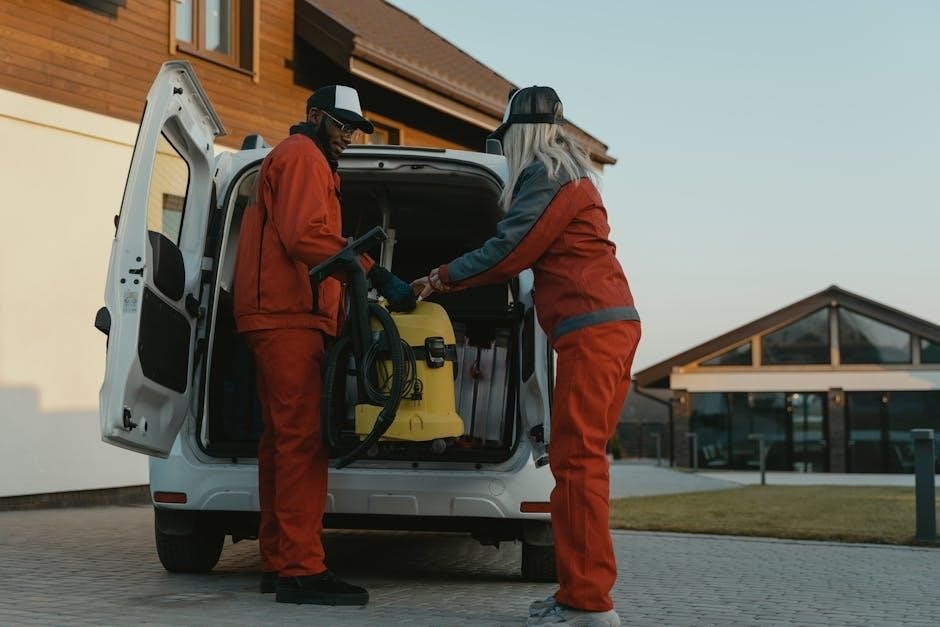Purchasing a cargo van involves careful consideration of purpose, budget, and size. This guide helps you navigate the process, from research to test drives and inspections, ensuring you find the perfect vehicle for your needs.
Understanding the Importance of Choosing the Right Cargo Van
Selecting the right cargo van is crucial for efficiency, reliability, and cost-effectiveness. It ensures the vehicle meets your specific needs, whether for business or personal use. A well-chosen van optimizes performance, reduces maintenance costs, and enhances productivity. Considering factors like size, capacity, and specialized features helps tailor the van to your operations, making it a valuable long-term investment. Proper selection also impacts insurance and registration requirements, ensuring compliance and safety standards are met.
Overview of the Buying Process
The buying process involves defining needs, budgeting, and researching models. It includes evaluating new vs. used options, checking vehicle history, and customizing features. Test drives and professional inspections are essential steps. Finalizing the purchase requires negotiating deals and ensuring proper documentation. This structured approach helps buyers make informed decisions, ensuring they find a van that meets their requirements and budget, while also addressing long-term maintenance and operational needs effectively.

Defining Your Needs and Purpose
Identify whether the van is for business or personal use. Determine required cargo space, payload capacity, and specialized features. This clarity ensures you select the right vehicle.
Assessing Your Business or Personal Requirements
Evaluate how the van will be used daily. For business, consider payload, cargo space, and upfitting needs. For personal use, prioritize comfort and versatility. Assessing your needs ensures the van meets your lifestyle or operational demands effectively, avoiding unnecessary costs and optimizing functionality.
Determining the Necessary Size and Capacity
Choose a van that matches your load requirements. Compact vans are ideal for small payloads, while full-size models offer more space and durability. Measure your typical cargo to ensure the van’s dimensions suit your needs. Proper sizing balances efficiency, maneuverability, and cost, preventing overcrowding or underutilization of space.
Budgeting for Your Cargo Van
Establish a clear budget considering purchase price, insurance, maintenance, and fuel costs. Long-term financial planning ensures sustainable ownership and avoids unexpected expenses.
Setting a Purchase Price Range
Set a realistic price range by assessing your budget and comparing cargo van models. New vans typically cost between $25,000 to $50,000, while used options start at $10,000. Consider financing options and long-term costs to narrow your search effectively.
Calculating Ongoing Costs (Insurance, Maintenance, Fuel)
Estimate insurance premiums, which vary based on usage and van type. Maintenance costs depend on mileage and model reliability. Fuel efficiency differs by size and engine type. Larger vans may have higher fuel consumption. Research annual estimates to budget accurately and avoid unexpected expenses, ensuring long-term financial stability for your cargo van ownership.

Exploring Cargo Van Types and Sizes
Explore various cargo van types and sizes, from compact to full-size models like Ford Transit, Mercedes Sprinter, and Ram ProMaster. Consider your business needs and operational demands to choose the right fit, ensuring optimal space and functionality for your workload.
Popular Cargo Van Models (Ford Transit, Mercedes Sprinter, Ram ProMaster)
The Ford Transit, Mercedes Sprinter, and Ram ProMaster are top choices in cargo vans. The Transit is known for its versatility and durability, while the Sprinter offers advanced technology and customization options. The ProMaster, with its spacious interior and efficient engine, is ideal for urban deliveries. Each model caters to different business needs, ensuring reliability and performance for various industries.
Compact vs. Full-Size Vans: Pros and Cons
Compact vans offer better fuel efficiency and lower costs, ideal for urban deliveries. However, they lack space and payload capacity. Full-size vans provide ample room and higher payload, making them perfect for heavy-duty tasks but at a higher price and lower fuel efficiency. Choose based on your specific needs, balancing cost, space, and performance for optimal results.

Researching Specific Models
Researching specific cargo van models involves comparing features, performance, and reliability. Look for reviews, performance data, and customer feedback to make an informed decision.
Comparing Features Across Different Models
When comparing cargo van models, consider fuel efficiency, cargo space, and customization options. The Ford Transit offers versatility, while the Mercedes Sprinter excels in luxury and technology. The Ram ProMaster provides ample storage and maneuverability. Each model caters to different needs, so prioritize features like payload capacity, towing ability, and interior configurations to match your specific requirements.
Reliability and Performance of Leading Brands
Leading brands like Ford, Mercedes, and Ram are known for reliable cargo vans. Ford Transit is praised for its durability and performance, while Mercedes Sprinter offers advanced tech and comfort. Ram ProMaster stands out for its efficient design and lower maintenance costs. Each brand delivers unique strengths, ensuring longevity and dependability for both personal and business use, making them top choices in the market.

Evaluating the Condition of the Van
Check for rust, dents, and wear on the exterior and interior. Inspect tires, brakes, and engine performance. Review maintenance records and mileage to ensure reliability and longevity.
Buying New vs. Used: Advantages and Disadvantages
Buying new offers warranties, latest features, and lower maintenance costs, but comes with a higher purchase price. Used vans are more affordable but may require immediate repairs and lack modern technology. Insurance for new vans is often cheaper, while used vans might have higher insurance rates due to unknown history. Consider budget, needed reliability, and long-term costs when deciding between new or used cargo vans.
Checking Vehicle History and Maintenance Records
Obtaining a detailed vehicle history report is crucial to uncover past accidents, ownership, and potential issues. Review maintenance records to ensure regular servicing and identify any neglected repairs. Look for consistent mileage logs and verify the van’s registration status. A clean history and well-documented maintenance can significantly reduce risks and ensure reliability, especially for used cargo vans.
Customization and Upfitting
Customizing your cargo van enhances functionality and comfort, allowing tailored solutions for specific needs, ensuring optimal use of space and efficiency in daily operations and long-term goals.
Essential Upfits for Cargo Vans (Shelves, Storage Solutions)
Essential upfits include shelves, cabinets, and modular storage systems, which maximize space efficiency. These solutions help organize tools, equipment, and supplies, ensuring easy access and reducing clutter. Customizable options like adjustable shelving and secure compartments enhance productivity. Additionally, ergonomic designs improve workflow, making tasks more efficient and reducing the risk of injury. Proper storage solutions are vital for safeguarding cargo and optimizing van functionality.
Considering Specialized Features for Your Industry
Depending on your industry, specialized features can enhance functionality. For example, refrigeration units for food transport, shelving for contractors, or medical equipment for healthcare. Tailored upfits like ladder racks or partitions can meet specific needs. Researching industry-specific requirements ensures your van is equipped to handle demanding tasks efficiently, boosting productivity and compliance with industry standards. Customization options are key to optimizing your van for professional success.
Insurance and Registration
Ensure your cargo van meets legal requirements with proper insurance and registration. Research industry-specific coverage options and secure necessary permits for business use, maintaining compliance always.
Understanding Insurance Requirements for Cargo Vans
Insurance for cargo vans varies based on usage, with policies covering liability, collision, and cargo damage. Commercial insurance is typically required for business use, while personal plans may suffice for private needs. Premiums depend on the van’s value, driver history, and coverage level. Always verify insurance requirements with your provider to ensure compliance and adequate protection for your investment.
Registering Your Van for Business Use
Registering your cargo van for business use requires specific documentation, including proof of ownership, insurance, and a completed registration form. A VIN inspection may also be necessary. Fees vary by jurisdiction, and commercial registration often costs more than personal use. Ensure all paperwork is completed accurately to avoid delays. Proper registration is essential for legal operation and may be required for insurance and tax purposes.
Test Driving and Inspection
- Test driving helps evaluate performance, comfort, and suitability for your needs.
- Inspect for signs of wear, damage, or needed repairs.
- Check mechanical components, tires, and interior features thoroughly.
What to Look for During a Test Drive
- Evaluate performance, comfort, and handling to ensure it meets your needs.
- Check acceleration, braking, and maneuverability in various conditions.
- Assess noise levels, transmission smoothness, and overall ride quality.
- Inspect for any unusual vibrations or warning lights on the dashboard.
- Test cargo space functionality and ease of loading/unloading.
- Ensure all features, like heating/cooling, work properly during the drive.
Professional Inspection Tips
- Hire a certified mechanic to inspect the vehicle for hidden issues.
- Check for signs of wear on brakes, suspension, and tires.
- Inspect the engine for leaks, rust, or excessive wear.
- Review maintenance records to ensure routine servicing.
- Look for any damage to the cargo area or body panels.
- Test electrical systems, including lights, wipers, and signals.
- Check the condition of the battery and charging system.
Finalizing the Purchase
Review and negotiate terms, ensure all documentation is complete, and finalize payments. Confirm insurance and registration requirements before completing the transaction.
Negotiating the Best Deal
Negotiate the price based on market research, comparing similar models and their features. Consider mileage, condition, and additional costs like insurance. Use competitor pricing to leverage a better deal. Inquire about discounts or incentives, and don’t hesitate to walk away if terms aren’t favorable. Ensure all agreed-upon extras, like extended warranties, are included in the final agreement before signing.
Ensuring All Documentation is in Order
Verify the vehicle’s history report, title, and service records. Ensure all contracts and financing agreements are thoroughly reviewed. Check insurance requirements and registration processes for business use. Confirm that all necessary permits and licenses are obtained. Understand warranty terms and any additional coverage. Keep copies of all documents for future reference, ensuring compliance with legal and regulatory standards.
By following this guide, you’ll make an informed decision, ensuring your cargo van meets your needs and sets you up for success in your endeavors.
Final Checklist Before Making a Decision
- Assess your business or personal needs to ensure the van fits your requirements.
- Verify the vehicle’s history and maintenance records for used vans.
- Check insurance and registration requirements for business or personal use.
- Ensure the van’s size and capacity match your operational demands.
- Review financing options and calculate ongoing costs (fuel, maintenance).
- Test drive the van to evaluate performance and comfort.
- Consider upfitting needs for shelving or specialized features.
- Ensure all documentation, including warranty and service records, is in order.
- Compare reliability and performance across leading models.
This checklist ensures a comprehensive evaluation, helping you make a confident, informed decision.
Next Steps After Purchasing Your Cargo Van
After purchasing, register and insure your van according to business or personal use requirements. Schedule a maintenance check to ensure everything is in working order. Organize any necessary upfitting, such as shelving or storage solutions. Familiarize yourself with the van’s features and driver training if needed. Arrange proper parking and storage. Finally, set up a maintenance schedule to keep your van in optimal condition.